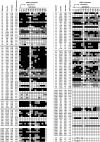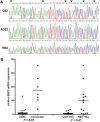DNA hypermethylation and aberrant expression of the EMP3 gene at 19q13.3 in Human Gliomas
- PMID: 17610521
- PMCID: PMC8095531
- DOI: 10.1111/j.1750-3639.2007.00083.x
DNA hypermethylation and aberrant expression of the EMP3 gene at 19q13.3 in Human Gliomas
Abstract
Allelic losses on 19q are found in the majority of oligodendroglial tumors and approximately one-third of diffuse astrocytomas. However, the tumor suppressor genes (TSG) on 19q are still elusive. Using cDNA microarray expression profiling, EMP3 at 19q13.3 was among those genes showing the most pronounced expression differences. In line with this, other authors reported EMP3 as being epigenetically silenced in neuroblastomas and astrocytomas. To further investigate EMP3 as a TSG candidate on 19q13.3, we performed molecular analysis of this gene in 162 human gliomas. Mutation analysis did not reveal EMP3 alteration in 132 gliomas. In oligodendroglial tumors, we found that aberrant methylation in the 5'-region of EMP3 was significantly associated with reduced mRNA expression and LOH 19q. In astrocytomas, EMP3 hypermethylation was also paralleled by reduced expression but was independent of the 19q status. EMP3 hypermethylation was detected in more than 80% of diffuse, anaplastic astrocytomas and secondary glioblastomas. Primary glioblastomas, however, mostly lacked EMP3 hypermethylation and frequently overexpressed EMP3. Our data corroborate that oligodendroglial and astrocytic gliomas often show EMP3 hypermethylation and aberrant expression. Furthermore, our findings suggest that primary and secondary glioblastomas are not only characterized by distinct genetic profiles but also differ in their epigenetic aberrations.
Figures



References
-
- Alaminos M, Davalos V, Ropero S, Setien F, Paz MF, Herranz M, Fraga MF, Mora J, Cheung NK, Gerald WL, Esteller M (2005) EMP3, a myelin‐related gene located in the critical 19q13.3 region, is epigenetically silenced and exhibits features of a candidate tumor suppressor in glioma and neuroblastoma. Cancer Res 65:2565–2571. - PubMed
-
- Alonso ME, Bello MJ, Gonzalez‐Gomez P, Arjona D, Lomas J, De Campos JM, Isla A, Sarasa JL, Rey JA (2003) Aberrant promoter methylation of multiple genes in oligodendrogliomas and ependymomas. Cancer Genet Cytogenet 144:134–142. - PubMed
-
- Cairncross G, Berkey B, Shaw E, Jenkins R, Scheithauer B, Brachman D, Buckner J, Fink K, Souhami L, Laperierre N, Mehta M, Curran W (2006) Phase III trial of chemotherapy plus radiotherapy compared with radiotherapy alone for pure and mixed anaplastic oligodendroglioma: Intergroup Radiation Therapy Oncology Group Trial 9402. J Clin Oncol 24:2707–2714. - PubMed
-
- Dong SM, Pang JC, Poon WS, Hu J, To KF, Chang AR, Ng HK (2001) Concurrent hypermethylation of multiple genes is associated with grade of oligodendroglial tumors. J Neuropathol Exp Neurol 60:808–816. - PubMed
-
- Ehrbrecht A, Muller U, Wolter M, Hoischen A, Koch A, Radlwimmer B, Actor B, Mincheva A, Pietsch T, Lichter P, Reifenberger G, Weber RG (2006) Comprehensive genomic analysis of desmoplastic medulloblastomas: identification of novel amplified genes and separate evaluation of the different histological components. J Pathol 208:554–563. - PubMed
Publication types
MeSH terms
Substances
LinkOut - more resources
Full Text Sources
Medical
Miscellaneous

